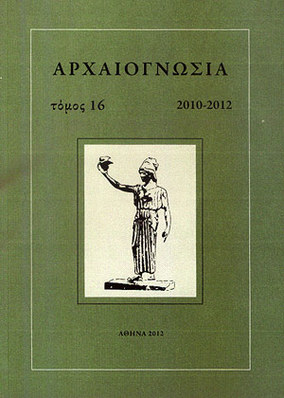Οι νεοελληνικές λαϊκές παραλλαγές της μυθιστορίας του Αισώπου και η παράδοσή τους
Part of : Αρχαιογνωσία ; Vol.9, No.1-2, 1995, pages 11-34
Issue:
Pages:
11-34
Parallel Title:
The neohellenic popular versions of the Aisop romance and their tradition
Section Title:
Μελέτες-Articles
Abstract:
Despite their importance for the cultural history of the Greek people, especially under the Ottoman empire, and the study of the development of the Greek language, the Modern Greek translations of the fictional Aesop Romance or Life of Aesop are still inedited. To date, not even a comprehensive list of the manuscripts preserving them has been published, which would be a prerequisite for their comparative study, collation, and critical edition of the translations. This paper aims to fill this gap and thus stimulate interest in editing these texts. Whenever possible, the ancient Greek or Byzantine version is noted from which the text of the individual manuscripts seems to descend. Eleven codices are discussed. One of them (number 11 in our numeration, above) contains a very brief «biographical» sketch of Aesop (printed on p. 30, note 62), which does not belong to the tradition of the Aesop Romance, despite the impression that might be gained by its description in the relevant Catalogue. Another manuscript, reported to be on the island of Zakynthos (above, no. 6), was inaccessible, but attention is called to its existence, since it has escaped the notice of scholars working in the field. From the relevant Catalogue we learn that its text descends from the paraphrase of the ancient text composed by the prolific Byzantine scholar Maxi- mos Planudes (= Planudea, on which see above, p. 14, note 12). The rest of the manuscripts preserve several independent translations, all written during the time of the Ottoman occupation of Greece, which descend either from Planudes’ paraphrase or/and one or the other of two branches of the so-called Westermanniana (or Vita W) version of the Aesop Romance (which was also the source of the Planudean paraphrase). The manuscripts may be divided into the following categories,- on the basis of the translation that they contain:(1) Cod. Atheniensis (National Library) 2993 (our no. 3), which preserves an extensive fragment of what is appartently the oldest Modern Greek translation. This is the only text published to date, and it is traceable to the MORAt branch of the Westermanniana. (2) Cod. Atheniensis (National Library) 1205, Constantinopolitanus (of the Μεγάλη τού Γένους Σχολή) 3 (64), Barlaam Monastery (at Meteora), 197, and Hagia Trias Monastery (also at Meteora) 84 (our nos. 1, 4, 7, and 8). They may be divided into two sub-groups, because the first two manuscripts seem to be closely related, as do the last two. This is the most broadly witnessed translation, and at least its beginning has been influenced in terms of both style and content by another fictional and very popular «biography», the Bertoldo of G. C. (dalla) Croce (see pp. 22-25). Since the first translation - into demotic Greek - of this Italian comic novel was printed in 1646, this year also becomes the terminus post quern for the composition of this translation of Aesop’s Life. Sources of the translation were both the SBPTh branch of the Westermanniana and the Planudean paraphrase. (3) Cod. Atheniensis (National Library) 2958 (our no. 3). Its text seems to descend from the Planudea and is closely related to the one preserved in the manuscript discussed next. (4) Cod. Athous 4297 (of Ίβήρων Monastery 177), written in 1617 (our no. 5). This translation, too, descends from the Planudea and is related, as already noted, to the translation in the preceding codex. (5) Cod. Athous 2416 (of Ξηροποτάμου Monastery 83) and 1782 (of Μεγίστης Λαύρας Monastery M 91). These two kindred codices (our nos. 9 and 10) preserve still another translation, derived from the Planudea. Its text is constantly interrupted by copious, supposedly explanatory, but mostly superfluous or even inane insertions of synonyms and roughly synonymous expressions, intended for school exercises in accordance with a method called ψυχαγωγία.In the “ADDENDUM” appended to the end of this paper, additional information is provided on two manuscripts and on their relation to the edition of 1644. This edition has been generally considered the only witness preserving one of the Modern Greek translations (see above, p. 12, note 4). It is demonstrated, however, that the translation is preserved not only in one of the unnoticed, “new” manuscripts discussed here for the first time (cod. Atheniensis [National Library] 2958), but to a large extent also in cod. Athous 4297 (Ίβήρων Monastery 177), which has been known for some time to scholars in the field. Evidently, these two manuscripts preserve at least in part the same translation, despite some significant differences in their texts.
Subject:
Subject (LC):
Keywords:
μυθολογία




